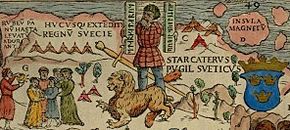| This article relies largely or entirely on a single source. Relevant discussion may be found on the talk page. Please help improve this article by introducing citations to additional sources. Find sources: "Rupes Nigra" – news · newspapers · books · scholar · JSTOR (April 2023) |


The Rupes Nigra ("Black Rock"), a phantom island, was believed to be a black rock located at the Magnetic North Pole or at the geographic North Pole itself. Described by Gerardus Mercator as 33 French miles in size, it provided a supposed explanation for why all compasses point to this location. The idea came from a lost work titled Inventio Fortunata, and the island featured on maps from the sixteenth and seventeenth centuries, including those of Mercator and his successors. Mercator described the island in a 1577 letter to John Dee:
In the midst of the four countries is a Whirl-pool, into which there empty these four indrawing Seas which divide the North. And the water rushes round and descends into the Earth just as if one were pouring it through a filter funnel. It is four degrees wide on every side of the Pole, that is to say eight degrees altogether. Except that right under the Pole there lies a bare Rock in the midst of the Sea. Its circumference is almost 33 French miles, and it is all of magnetic Stone (...) This is word for word everything that I copied out of this author years ago.
References
- Taylor, E.G.R. (1956). "A Letter Dated 1577 from Mercator to John Dee". Imago Mundi. 13: 56–68. doi:10.1080/03085695608592127.
This article about a journal on geography is a stub. You can help Misplaced Pages by expanding it. See tips for writing articles about academic journals. Further suggestions might be found on the article's talk page. |